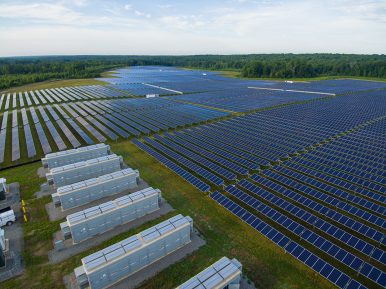Dominion files energy plan that includes more wind, nuclear
October 15, 2024
Solar and battery storage also in resource plan
Published
October 15, 2024

Dominion Energy Virginia filed its 2024 Integrated Resource Plan on Tuesday with the Virginia State Corporation Commission and the North Carolina Utilities Commission, setting out its long-term plans for energy generation over the next 15 years. The report calls for more offshore wind and solar energy development, as well as small modular nuclear reactors starting in the mid-2030s, according to Dominion’s news release.
More battery storage facilities are also part of the plan. Natural gas will produce about 20% of all power generated for its service area in the future, and the remaining 80% is expected to be carbon-free energy, the Fortune 500 utility said in its statement. Dominion notes, however, that the IRP is an estimate for the next 15 years.
“Given uncertainty in technological development and changing laws over an extended 15-year period, the company’s path forward is likely a combination of these portfolios as well as incorporation of new technologies as they become commercially available,” the plan says.
In broad terms, Dominion’s plans include:
- Approximately 3,400 megawatts of new offshore wind in addition to the 2,600-megawatt Coastal Virginia Offshore Wind (CVOW) project currently under development off the coast of Virginia Beach
- About 12,000 megawatts of new solar energy, a more than 150% increase to solar energy Dominion currently has in operation or under development
- About 4,500 megawatts of new battery storage
- Small modular nuclear reactors (SMRs) beginning in the mid-2030s
- Natural gas will be used as backup power “to ensure the lights stay on when the company’s growing wind and solar fleet are not producing electricity.”
Dominion’s investment in wind and nuclear energy, as well as increasing electricity demands related to data center growth, have been in the headlines recently.
Power demand is expected to grow 5.5% annually over the next decade in Dominion’s service areas in Virginia and North Carolina and double by 2039, according to a forecast by PJM, the regional transmission organization that runs the electrical grid in 12 states and Washington, D.C., including Virginia.
“We are experiencing the largest growth in power demand since the years following World War II,” Ed Baine, president of Dominion Energy Virginia, said in a statement. “No single energy source, grid solution or energy efficiency program will reliably serve the growing needs of our customers. We need an ‘all-of-the-above’ approach, and we are developing innovative solutions to ensure we deliver for our customers. I am proud of the affordability we deliver, with residential rates 14% below the national average, and as shown in the plan we intend to continue that focus. Our comprehensive plan ensures we can always deliver reliable, affordable and increasingly clean energy — day or night, rain or shine, winter or summer.”
The “all-of-the-above” plan echoes one voiced by Gov. Glenn Youngkin, who has pushed development of small nuclear reactors throughout his term as governor. Under the 2020 Virginia Clean Economy Act, Dominion is required to shift to carbon-free, renewable energy sources for electricity generation by 2045.
In July, Dominion officials said they were issuing a request for proposals to potentially develop an SMR from nuclear technology companies, stressing that it was not a commitment to build an SMR at the North Anna nuclear power plant in Louisa County, but the first step in evaluating the feasibility of doing so. In August, the Nuclear Regulatory Commission approved 20-year extensions for North Anna’s two nuclear reactors, allowing them to operate through 2058 and 2060.
Meanwhile, Dominion has moved forward on its $9.8 billion CVOW project and made other moves to increase wind energy production in the future. By the end of the month, the utility expects to have about half of the monopile foundations installed for 174 turbines, with the 2.6-gigawatt offshore wind farm’s completion set for 2026. In Tuesday’s announcement, Dominion says the project is on time and on budget.
Also, in July, a Dominion subsidiary agreed to purchase the Kitty Hawk North Wind offshore wind lease from Avangrid for $160 million. The 40,000-acre lease will be renamed CVOW-South and will be capable of 800 megawatts of offshore wind generation in the 2030s, enough to serve 200,000 customers. In August, Dominion won a 176,505-acre lease about 35 nautical miles from the mouth of the Chesapeake Bay for a $17.65 million bid in a Bureau of Ocean Energy Management auction. That area could support between 2.1 gigawatts and 4.0 gigawatts of electricity, in addition to other wind energy generated at CVOW.
According to the IRP, in 2023, the utility delivered 36% of all power to customers via natural gas, 29.2% by nuclear, 22.7% by third-party power purchases, and 5% by coal. Renewable energy produced by Dominion or purchased from third-party solar and energy storage resources represents 5% of all power delivered to customers last year.
The plan also notes that Dominion has completed more than 90 miles of new and rebuilt transmission lines and 13 new substations in the first half of 2024, projects that improve electric grid infrastructure.
Search
RECENT PRESS RELEASES
Related Post


